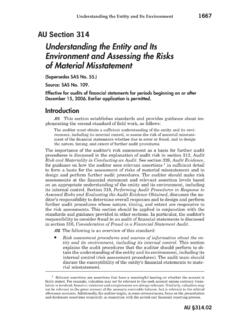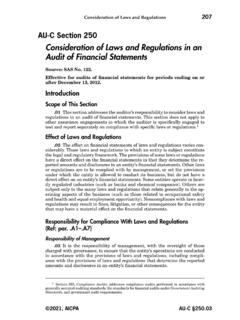Transcription of Accounting and Financial Reporting Update Interpretive …
1 Life SciencesAccounting and Financial Reporting Update Interpretive Guidance on ContingenciesMarch 20182 ContingenciesIntroductionASC 450 defines a contingency as an existing condition, situation, or set of circumstances involving uncertainty .. that will ultimately be resolved when .. future events occur or fail to occur. In the life sciences industry, contingencies often arise as a result of product liability issues; patent litigation cases, such as suits filed against the entity for patent infringement ( , generic at-risk launches); and compliance issues related to pricing, promotions, or manufacturing standards . In addition, for biotech and pharmaceutical firms, environmental issues and remediation proceedings have been the subject of considerable public and legislative discussion and initiatives.
2 As a result, Accounting standard setters such as the FASB, AICPA, and SEC have emphasized the Accounting for and disclosure of environmental liabilities in the Financial the life sciences industry, a single event could trigger multiple contingencies, requiring an entity to separately evaluate each contingent liability to determine its appropriate recognition, measurement, and classification. For example, a regulatory action may result in the incurrence of incremental costs related to product recalls, leading to a change in product strategy, adjustments to customer sales allowances, or other events. Further, a litigation settlement may contain multiple elements, including cash payments, required future services, rights to IP, and other agreements or concessions between the Accounting for and disclosures about contingencies under ASC 450 differ depending on whether the contingency could result in a gain or a loss.
3 In addition to providing general disclosure guidance on both gain and loss contingencies, ASC 450 discusses specific application of the guidance to unasserted claims, litigation , guarantees, and events occurring after the date of the Financial statements but before their issuance, all of which are common in the life sciences 450 defines a loss contingency as an existing condition, situation, or set of circumstances involving uncertainty as to possible loss to an entity that will ultimately be resolved when one or more future events occur or fail to occur. Accrual of an estimated loss contingency through a charge against earnings is required if it is probable that an asset has been impaired or a liability has been incurred as of the date of the Financial statements and the amount of the loss can be reasonably estimated.
4 If the estimated amount of loss is within a range of amounts, and some amount within the range of loss appears to be a better estimate than any other amount within the range, companies must accrue that amount. If no amount within the range of loss is a better estimate than any other amount, companies must accrue the minimum amount within that range of loss. Disclosure of the nature of the accrued loss 3 Contingencies and, in some circumstances, the amount accrued may be required so that the Financial statements are not misleading. With respect to unrecognized loss contingencies, ASC 450-20-50-3 and 50-4 note the following:ASC 450-2050-3 Disclosure of the contingency shall be made if there is at least a reasonable possibility that a loss or an additional loss may have been incurred and either of the following conditions exists:a.
5 An accrual is not made for a loss contingency because any of the conditions in paragraph 450-20-25-2 are not An exposure to loss exists in excess of the amount accrued pursuant to the provisions of paragraph 1 3 (see paragraphs 450-20-55-18 through 55-37) illustrate the application of these disclosure The disclosure in the preceding paragraph shall include both of the following:a. The nature of the contingencyb. An estimate of the possible loss or range of loss or a statement that such an estimate cannot be gain contingency arises if the outcome of future events may result in a possible gain or benefit to an entity ( , pending litigation whose outcome would result in a benefit). Unlike a loss contingency, a gain contingency is usually not reflected in the Financial statements and should not be recorded in the Financial statements before the contingency is realized.
6 However, as stated in ASC 450-30-50-1, [a]dequate disclosure shall be made of a contingency that might result in a gain, but care shall be exercised to avoid misleading implications as to the likelihood of realization. Industry IssuesThe Q&As in the sections below discuss guidance on contingency-related topics that frequently affect life sciences RecallsLife sciences entities may be subject to recalls on their products ( , medical devices, pharmaceutical drugs). While some product recalls are voluntary ( , the drug manufacturer has chosen to take the drug off the shelves or notified consumers and doctors to stop using the product or return it), other recalls may be required by the FDA or other should the liability recognition criteria of ASC 450-20-25 be applied to a product recall obligation?4 Deloitte | Life Sciences: Accounting and Financial Reporting Update AnswerWhen the guidance in ASC 450-20 is applied to product recalls, the obligating event triggering liability recognition is the announcement of a recall.
7 Except as provided for in a warranty arrangement, a company has no legal obligation or duty associated with product design or manufacturing defects after the product is sold. Because there is no legal obligation, there is no event that gives rise to a probable loss until a recall is announced voluntarily or is mandated by regulators. Product recall costs should be recorded upon announcement as an operating cost in the Financial statements rather than as an extraordinary item because they result from an inherent business Offers to Settle LitigationOne of the major uncertainties in the life sciences industry is the risk of litigation . Class actions, individual suits, and actions brought by government agencies are not uncommon, and such contingencies may need to be accounted for or disclosed in the Financial statements ( , a potential future obligation related to an uncertain amount resulting from past activities).
8 With respect to pending or threatened litigation , ASC 450 requires the accrual of a loss contingency if certain criteria are met. Entities will often make offers to settle existing litigation ; the Accounting for the offer should be based on existing facts and circumstances associated with the litigation and related an offer by management to settle litigation need to be accrued in the Financial statements?AnswerAn offer to settle litigation creates a strong presumption that it is probable that a liability has been incurred. The settlement offer presumably establishes a low end of the range under ASC 450-20-30-1, resulting in accrual of a liability. Withdrawal of a settlement offer before acceptance and before issuance of the Financial statements generally would not change this conclusion since the existence of the offer indicates that a probable obligation existed as of the date of the Financial limited circumstances, it might be possible to overcome the presumption that an offer to settle litigation triggers accrual of a liability and establishes a low end of the range.
9 However, rebutting the presumption should be a high hurdle to overcome and should be based on persuasive evidence to the contrary. At a minimum, the evidence would need to substantiate that it is remote that (1) the offer will be accepted and (2) further negotiations will lead to an out-of-court settlement. One form of such evidence could be an unequivocal representation from legal counsel. A company that believes that the presumption has been overcome should consider consulting with its Accounting In January 2015, the FASB issued ASU 2015-01 to eliminate the concept of extraordinary items from GAAP. The ASU became effective for fiscal years, and interim periods within those fiscal years, beginning after December 15, 2015, and early adoption was permitted if the guidance was being applied as of the beginning of the fiscal year of ExampleCompany X is in the medical device business.
10 Over the past year, X has been named as the defendant in a lawsuit alleging personal injury resulting from use of one of its surgical devices. After year-end, but before issuance of the annual Financial statements, X offers to settle the litigation for $1 million. Management of X contends that this offer was made solely to accelerate the process of resolving the dispute. The plaintiff has not responded to the offer. Company X believes that if the matter ultimately goes to trial, the plaintiff will not prevail with its offer to settle is evidence that it is probable that a liability has been incurred as of the date of the Financial statements and that the amount of the loss can be reasonably estimated. Company X should consider the guidance in ASC 450-20-30-1 in determining the appropriate amount to accrue.













